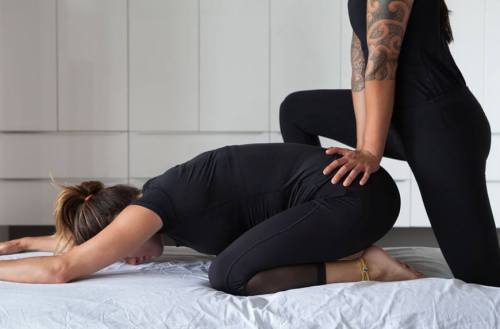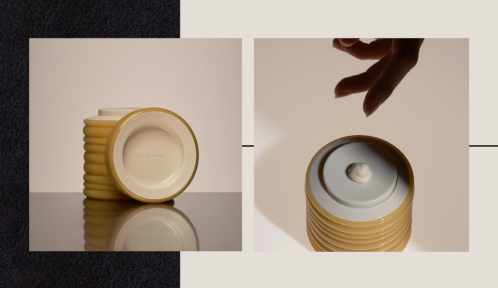On the surface, massage and sports massage can look pretty similar—you strip down, hop onto a table, and feel your knots slowly untangle. When you dig in (quite literally) to learn more about each, however, you’ll discover they actually feel pretty different. So what exactly distinguishes the two—and, more importantly—how do you know which one is right for you based on your recovery goals?
“Very simply put, both regular massage and sports massage use touch to increase blood flow to an area of the body,” says Joni Honn owner of Genuine Touch Massage in Houston, Texas. Whether you’re looking for an experience that’s as relaxing as calming mists or a detoxifying charcoal soak or you need something to help you “sport,” I asked four master massage therapists for their insights here.
Here’s the lowdown on massage and sports massage—and how to know which your body needs.

What exactly is a massage?
It’s no secret that a little massage can leave you blissed out— and maybe even ready for bed, which is why it’s a must on oh-so-many vacations. “A traditional massage is something designed for relaxation. It’s the type of thing that you’d do in a spa, or if you have muscle discomfort that you might describe as ‘kinks in your back’ or ‘knots in your neck’,” says certified orthopedic manual therapist Barret LaMond, PT, DPT, COMT at Select Physical Therapy in Houston.
The technique is different from a sports massage, in that it’s more of a full-body experience, rather than targeting a specific muscle group as you might in sports massage. “Usually a massage therapist will use sweeping strokes all over your body— these strokes usually are not as deep or as specific as they are in a sports massage—to promote relaxation,” says Katrina Baker licensed massage therapist and co-owner of Be Well Boston Clinical Massage Therapy. So if you’re looking for full-body relaxation versus having one spot that bothers you, a Swedish massage could be the way to go.
And while the sensory elements help for sure, it’s not the cucumber water, fluffy robes, or crystal display that makes a massage worth it, according to Honn, it’s the massage therapist. “I recommend choosing a massage therapist through referral,” she suggests. “Before booking any kind of massage, check out their credentials because you want someone who knows what they’re doing.” And you don’t have to wait until your next vacation for this: the Zeel app, allows you to book same-day, in-home massages straight from your smartphone.
And what exactly is a sports massage?
“Sports massages are for people who, as the name implies, are active,” says Honn, including everyone from rec soccer players to avid exercisers. But sports massage is also a great tool for anyone who wants to improve flexibility and mobility, decrease muscle tension, prevent injury, and increase their range of motion, according to Eva Carey, Director of Massage Therapy for Zeel. Uh, hello: That’s pretty much everyone.
Unlike regular massage, sports massage is a little less ooh and a little more ouch.
“The most notable difference between massage and sports massage is that for a Swedish massage, the therapist will typically have a routine that they use on everyone,” Baker tells me. “With sports massage this is never the case because each client is different and brings a different problem area to the table.”
While the benefits are numerous, unlike regular massage, sports massage might give you a little less ooh and a little more ouch. “Often sports massage can be uncomfortable or even painful, depending on how rigorous the massage therapist chooses to be and how much the athlete can tolerate,” says LaMond.
The technique of sports massage requires digging deeper into the tissue, to release the fascia— the white filmy stuff that sits on top of the muscle that can cause up to 2000 pounds of pressure, explains Honn. Releasing the fascia takes heavy pressure that may be painful from the masseuse, but it’s necessary in order to get to and open the muscle, she says. Sound a little intense? It is. But the benefits are immediate, says Honn. Just make sure to drink a lot of water in the days leading up to your appointment, and don’t be surprised if you’re a little sore after.
So which should you get?
You can’t go wrong with either option, as long as you know what to expect. “If you are someone that prefers deeper and more specific pressure, go for a sport massage,” Baker tells me. “If you’re looking for more full body and relaxation work, a regular [Swedish] massage is the way to go.”
“I think both are great components of a wellness,” says Honn. “Every type of massage is beneficial because you’re increasing the blood flow to that part of your body, which boosts recovery.” And while the effects of a regular massage are more about the experience, if you’re an athlete, a sports massage could be a your ticket better recovery. Win-win.
Can’t book an appointment? Turn your shower into a spa for the most relaxing shower of your life (trust us, it’s almost as good as a solid rubdown). Or give your crush this guide for giving an amazing massage( even if you have no idea what you’re doing) and enjoy.
Sign Up for Our Daily Newsletter
Get all the latest in wellness, trends, food, fitness, beauty, and more delivered right to your inbox.
Got it, you've been added to our email list.











